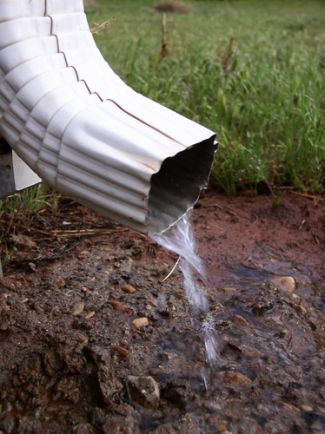Ground Water Control and Roof Drainage

Consider the volume of water that pours off your roof from rain during a typical year - it can be a huge amount! For example, when a 2,400 square foot roof receives a 1 inch rainfall, approximately 1,500 gallons of water will pour from this roof. If this property receives 35 inches of rain in a given year, 52,500 gallons of water will enter the soil near its foundation.
Assuming your basement has no leaks, the bulk of the rain water that enters the soil near your foundation will be pumped away by your sump pump. It is important to make sure that your sump pump discharges this water as far as possible from your house, so that it does not simply re-enter the soil near your foundation and get recycled back into your basement, overworking your pump.
Given the huge volume of rainfall that can drop on your home and the surrounding soil, well-functioning gutters and drainage systems are essential to prevent water from entering your home or damaging your foundation. Drain water and sump water should be piped away from your home, either into the public storm sewer system, if available, or to the lowest part of your property. Be sure to verify and comply with your local runoff codes for discharging this water responsibly.
Roof Gutters are Important
 Gutters are used to keep rain water from dripping down and accumulating around your home's foundation. If the soil around your home becomes saturated with water, extra pressure is placed on your basement walls. This can eventually cause your house to settle and can actually cause your basement walls to shift or bend inward, leading to structural damage. Additionally, water can begin to seep into your basement.
Gutters are used to keep rain water from dripping down and accumulating around your home's foundation. If the soil around your home becomes saturated with water, extra pressure is placed on your basement walls. This can eventually cause your house to settle and can actually cause your basement walls to shift or bend inward, leading to structural damage. Additionally, water can begin to seep into your basement.
Excess water draining into the soil around your home is an especially serious problem if you happen to live in an area with poor draining soil, such as soil with a high clay content.
Review our tips on how to clean gutters in order to protect your foundation.
French Drains and Footing Drains
 Use a French drain in your yard to act as a "gutter for ground water", to direct water away from your foundation during heavy rains when the ground gets saturated.
Use a French drain in your yard to act as a "gutter for ground water", to direct water away from your foundation during heavy rains when the ground gets saturated.
So, what is a French drain? A French drain is a tunnel containing stone and a perforated pipe, dug in a downward sloping grade. It is especially useful for keeping water from traveling toward your house from a high point in your yard. The trench diverts water that would otherwise be moving toward your foundation.
Most foundations have footing drains installed during initial construction. These systems of pipes, gravel, and a filtering material collect water near your foundation and redirect it, to prevent it from gathering at the exterior base of the foundation wall. If you find that water levels near your foundation seem high, find the outlets from your footing drainage and for any existing French drain systems you may have. Be sure these drain lines still function well. Clear the pipes if you detect that the water flow is restricted. Try checking these pipes during, or immediately after, heavy rainfall to confirm that water is flowing properly.
The topography of your lot is an important aspect of effective ground water control. Where possible, you want the grade of your property to slope away from your house so that water is naturally diverted away from it.
Given the enormous amount of water that falls on your roof and yard over time, it is important to make sure that the water-diverting systems on your property are functioning well. When you notice any deficiencies in your roof drainage or other drain systems, always fix them right away. By investing a little bit of time and money in periodic maintenance, you can save yourself from a tremendous amount of hassle.
Image source: toddneville
 The Ground Water Control and Roof Drainage by Water Damage Defense, is licensed under a Creative Commons Attribution-ShareAlike 3.0 Unported License.
The Ground Water Control and Roof Drainage by Water Damage Defense, is licensed under a Creative Commons Attribution-ShareAlike 3.0 Unported License.
